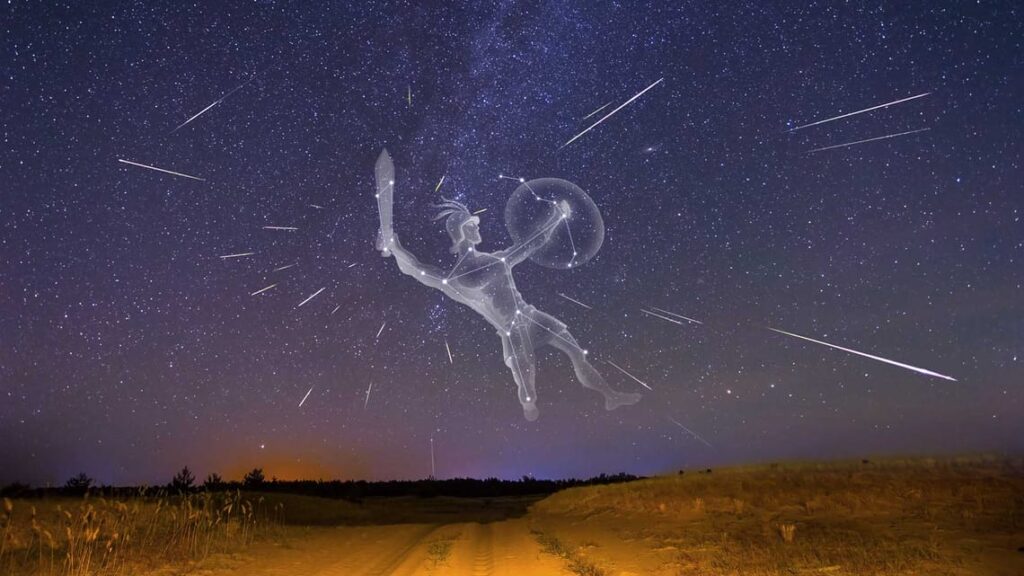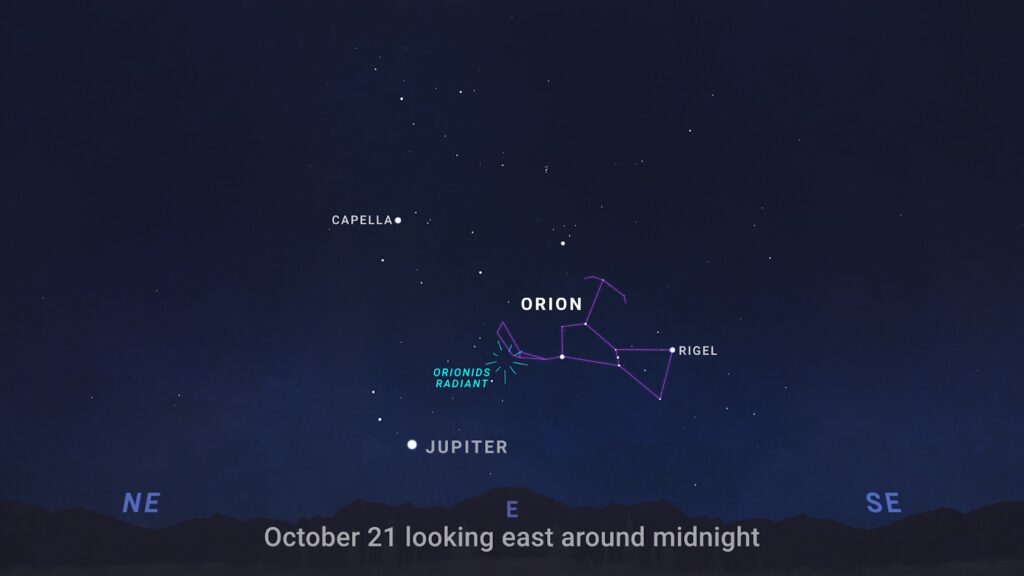If you love watching the night sky, October is bringing you one of the most awaited celestial events of the year — The Orionid Meteor Shower 2025! Known for its bright and fast meteors, the Orionids are truly a treat for stargazers. This shower is linked to the famous Halley’s Comet, making it not just beautiful but also scientifically fascinating.
Orionid Meteor Shower 2025: Where & How To See It This October
Whether you plan to join a meteor shower event in Pune or watch it from a quiet hillside, this October’s night sky promises an unforgettable experience.
What Is the Orionid Meteor Shower?
The Orionid meteor shower occurs every year when Earth passes through the trail of debris left by Halley’s Comet. These tiny particles of dust and ice, often no bigger than a grain of sand, enter our atmosphere at incredibly high speeds — around 66 km per second — and burn up, creating bright streaks of light we call meteors.
Even though Halley’s Comet only visits the inner solar system once every 76 years (it was last seen in 1986 and will return in 2061), Earth crosses its dust trail twice a year — once in May (Eta Aquarids) and again in October (Orionids).

image source – starwalk.space
When Will the Orionid Meteor Shower Peak in 2025?
The Orionid meteor shower will be active from September 26 to November 22, but the peak night will be on October 20–21, 2025.
During this time, you can expect to see about 20 to 30 meteors per hour, and if you’re lucky, you might even witness bursts of up to 80 meteors per hour!
The best time to watch will be from midnight to around 2 a.m., when the radiant — the point from which meteors appear to originate — is high in the sky near Orion the Hunter.

image source -https://science.nasa.gov/
Why 2025 Is a Great Year To Watch the Orionids
This year, conditions are especially favorable because the New Moon will ensure dark skies, allowing even faint meteors to shine brightly. With no moonlight interference, it’s the perfect opportunity for stargazing enthusiasts in Pune to enjoy long, glowing streaks across the Milky Way.
So, if you’ve ever missed the Orionids before, 2025 is your year to watch them in their full glory! Don’t miss out — several stargazing events near Pune will be organized to make the experience even more exciting.
Where To Look in the Sky
The Orionid meteors seem to radiate from the constellation Orion, one of the most recognizable patterns in the night sky. Look for Orion’s Belt — three bright stars in a straight line — and you’ll find the radiant just above that region, near Betelgeuse, the red supergiant star.
The Orionid meteors seem to radiate from the constellation Orion, one of the most recognizable patterns in the night sky. Look for Orion’s Belt — three bright stars in a straight line — and you’ll find the radiant just above that region, near Betelgeuse, the red supergiant star.
Best Places To Watch the Orionid Meteor Shower Near Pune
The Orionid Meteor Shower 2025 will peak on October 21, delivering up to 20 meteors per hour under ideal observing conditions. This year’s peak coincides with the New Moon, ensuring dark skies and clear visibility across the Pune region.
If you’re planning to enjoy this celestial spectacle, you don’t have to go far — Pune is surrounded by several dark-sky locations perfect for a stargazing or meteor shower event near Pune.
Here are some of the best stargazing places near Pune for watching the Orionids:
Velhe – A popular dark-sky destination about 50 km from Pune, ideal for meteor shower events and stargazing nights. Its pollution-free environment makes it perfect for viewing the Orionids.
Panshet – Located roughly 45 km from Pune, this scenic lakeside area offers wide open horizons, calm winds, and minimal light — ideal for a relaxed stargazing event near Pune.
Bhor – A peaceful countryside location surrounded by fields and open skies. It’s a great spot for spotting shooting stars and enjoying the Orionid meteor shower.
Mulshi – Known for its lake and forest backdrop, Mulshi offers a tranquil escape from the city’s glow — great for a meteor shower viewing night near Pune.
Lavasa Hills – About 60 km from Pune, this elevated location provides clear skies and stunning views, making it a favorite among astronomy photographers and stargazing groups.
If you can’t travel far, head to the outskirts of Pune — such as Sinhagad foothills, Pabe Ghat, or Tamhini Ghat. These spots still provide darker skies with minimal interference from city lights. So mark your calendar for October 21, grab your friends or family, and witness one of the most beautiful meteor shower events in Pune this year!
Best Time To Watch
Peak Night: October 20–21, 2025 – The Orionids will peak on October 21, delivering up to 20 meteors per hour under perfect observing conditions
Best Viewing Hours: Midnight to around 2:00 a.m. (when Orion is highest)
Duration: Active from September 26 to November 22, with maximum activity on the night of October 21
How To Watch the Orionid Meteor Shower
You don’t need a telescope or binoculars to enjoy the show — just your eyes, patience, and a dark spot. Follow these tips for the best experience:
1. Find a Dark Spot: Choose a location away from streetlights or bright buildings.
2. Get Comfortable: Bring a mat, blanket, or reclining chair. Carry warm clothes and a thermos of coffee or tea.
3. Let Your Eyes Adjust: Give yourself at least 20–30 minutes in the dark for better visibility.
4. Avoid Phone Screens: Bright light resets your night vision.
Photography Tips for Meteor Showers
If you enjoy astrophotography, the Orionids are a perfect opportunity to capture the magic of the night sky.
* Use a DSLR or mirrorless camera with a wide-angle lens (14mm–24mm).
* Set your ISO to 1600–3200 for brighter trails.
* Keep the shutter speed between 10–25 seconds.
* Focus manually on a bright star.
* Mount your camera on a sturdy tripod.
* Shoot continuously to increase your chances of catching multiple meteors.
Fun Fact: The Halley’s Comet Connection
Every streak of light you see during the Orionids is a tiny fragment of Halley’s Comet burning up in Earth’s atmosphere. It’s incredible to think that a comet last seen in 1986 still gives us a breathtaking sky show every October!
Interestingly, Halley’s Comet also creates the Eta Aquarid meteor shower in May each year — another highlight for astronomy fans and stargazing event participants in Pune.
Did You Know?
Halley’s Comet is the only known comet that causes two meteor showers every year — the Orionids (October) and the Eta Aquarids (May).
* The meteors you see tonight are tiny dust grains that broke away from Halley’s Comet centuries ago!
* Orionid meteors are among the fastest, zipping through Earth’s atmosphere at about 66 km per second.
* The name “Orionids” comes from the constellation Orion, as the meteors appear to radiate from that direction.
* Some bright Orionids leave glowing trails that linger for several seconds after the meteor has vanished — a perfect sight during a stargazing event in Pune!
